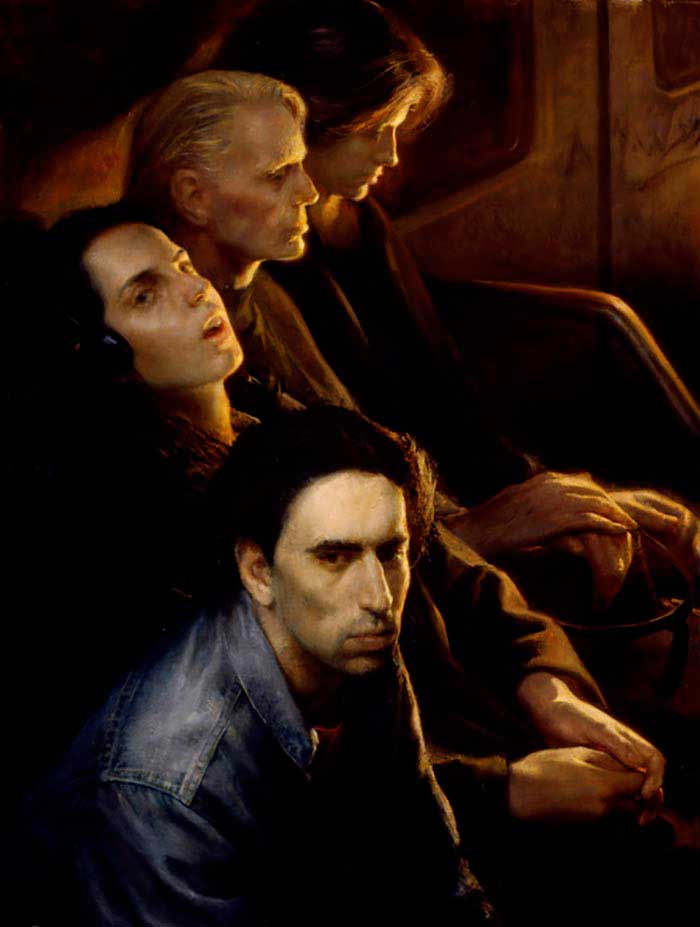Dear Artist,
“Every time I paint a portrait I lose a friend,” said John Singer Sargent. He may have been joking — his portraits combined a reasonable likeness with an elegance which often made sitters more aristocratic looking than they may have deserved.
 As well as likeness, the desired psychological depth comes with an understanding of the subject. The tools of the sitter’s trade — the objects of passion — are a good place to start. These paraphernalia, whether included in the painting or not, give a clue to personality and have an effect on how the subject might be handled. Tell the commissioner that you prefer to give some thought to what might be done, and later present them with your concepts in rough form. I make them rough, rough, roughs so I can change my mind a bit if I want. Ideally, I have several concepts, at least one of them non-conservative. Generally, this approach is respected and makes for more fun and potential quality. Customers often go for a concept different from what they originally had in mind.
While it’s a bit of a catering game, I love the challenge. This is one area of fine art where the greyhounds are separated from the griffons. I did a family-group portrait of three teenagers. First, I photographed them on location — part of my process — in this case a beach. I sorted my reference, stewed about my alternatives, prepared three pencil roughs of different sizes and formats, faxed them to the client with prices, got phone approval for the one I most wanted to do and started work within minutes. One by one I had the kids into my studio and laboured to get them right and fresh at the same time. After a week or so, the portrait was finished. I decided to deliver. The parents were excited when I drew the framed 30 x 34 inch painting out of a big box and set it under a light. They were silent. They moved around a bit. Eventually, the father, a high-priced lawyer noted for his courtroom smarts, turned to me, smiled, and asked, “Whose kids are those?”
Best regards,
Robert
PS: “A portrait is a picture in which there is just a tiny little something not quite right about the mouth.” (John Singer Sargent)
Esoterica: “Madame X,” painted in 1884, featured Madame Pierre Gautreau, an American from New Orleans who married French banker Pierre Gautreau. Her gown’s right shoulder strap was originally slipped. This provocative dress shocked the audience at the Paris Salon. Sargent fixed it. He eventually sold the portrait to the Metropolitan Museum of Art, to whose director he wrote in 1916, “I suppose it’s the best thing I’ve done.”
This letter was originally published as “Portrait” on November 3, 2000.
[fbcomments url=”http://clicks.robertgenn.com/painting-portrait.php”]
Featured Workshop: Judith Kruger
As well as likeness, the desired psychological depth comes with an understanding of the subject. The tools of the sitter’s trade — the objects of passion — are a good place to start. These paraphernalia, whether included in the painting or not, give a clue to personality and have an effect on how the subject might be handled. Tell the commissioner that you prefer to give some thought to what might be done, and later present them with your concepts in rough form. I make them rough, rough, roughs so I can change my mind a bit if I want. Ideally, I have several concepts, at least one of them non-conservative. Generally, this approach is respected and makes for more fun and potential quality. Customers often go for a concept different from what they originally had in mind.
While it’s a bit of a catering game, I love the challenge. This is one area of fine art where the greyhounds are separated from the griffons. I did a family-group portrait of three teenagers. First, I photographed them on location — part of my process — in this case a beach. I sorted my reference, stewed about my alternatives, prepared three pencil roughs of different sizes and formats, faxed them to the client with prices, got phone approval for the one I most wanted to do and started work within minutes. One by one I had the kids into my studio and laboured to get them right and fresh at the same time. After a week or so, the portrait was finished. I decided to deliver. The parents were excited when I drew the framed 30 x 34 inch painting out of a big box and set it under a light. They were silent. They moved around a bit. Eventually, the father, a high-priced lawyer noted for his courtroom smarts, turned to me, smiled, and asked, “Whose kids are those?”
Best regards,
Robert
PS: “A portrait is a picture in which there is just a tiny little something not quite right about the mouth.” (John Singer Sargent)
Esoterica: “Madame X,” painted in 1884, featured Madame Pierre Gautreau, an American from New Orleans who married French banker Pierre Gautreau. Her gown’s right shoulder strap was originally slipped. This provocative dress shocked the audience at the Paris Salon. Sargent fixed it. He eventually sold the portrait to the Metropolitan Museum of Art, to whose director he wrote in 1916, “I suppose it’s the best thing I’ve done.”
This letter was originally published as “Portrait” on November 3, 2000.
[fbcomments url=”http://clicks.robertgenn.com/painting-portrait.php”]
Featured Workshop: Judith Kruger

You may be interested to know that artists from every state in the USA, every province in Canada, and at least 115 countries worldwide have visited these pages since January 1, 2013.

“Essie, Ruby, and Ferdinand, Children of Asher Wertheimer”
oil on canvas, 63.58 x 76.18 inches
by John Singer Sargent, 1902


Homeless Part I oil on canvas by Steven Assael, New York, NY, USA |
Share.






